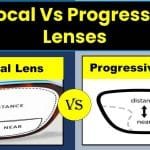What Is Astigmatism? Today’s topic is all about Astigmatism of Eye: Definition, Causes, Types, Symptoms, Astigmatism Test Online for Free, and Correction.
What is Astigmatism of Eye?
Astigmatism Definition: Astigmatism of the eye is a common refractive error that causes blurry vision. It is defined as an error that occurs due to imperfection or irregularity on the surface of the cornea (anterior transparent cover of the eye) or the natural crystalline lens inside the eye. The astigmatic eye isn’t completely round and most people have some degree of astigmatism.

The cornea and lens are the transparent media of the eye. Normally, these structures are smooth and equally curved in all meridians. It is crucial for incoming rays of light to sharply focus on the retina.
If cornea and lens (also retina) fail to maintain their smooth surface and curvature, the light can’t focus at a single point on the retina, and it is defined as astigmatism in the eye.
In most cases of the astigmatic eye, the cornea has two curves: a steeper curve and a flatter curve. Due to this difference in curvature of the cornea, light rays focus on more than one point on the retina, resulting in blurred vision.
How common is Astigmatism of Eye?
Thomas Young first reported astigmatism in 1801. Today, astigmatism has affected around 45% of the global population. Similarly, about 60% of cases with either myopia or hyperopia have astigmatism which needs to be corrected. Children, adults, and people of all ages can be affected by astigmatism. It occurs with equal frequency in females and males.
According to the degree of astigmatism of eye, the approximate distribution is as follows:
- 0.25 to 0.50D (diopter)-50%
- 0.75 to 1.00D-25%
- 1.25 to 4.00D-24%
- Greater than 4.00D-1%
The most common type of astigmatism in the eye is compound myopic astigmatism followed by compound hyperopic, mixed astigmatism, simple myopic, and simple hypermetropic astigmatism. The occurrences of with-the-rule astigmatism, against-the-rule astigmatism, and oblique astigmatism are:
- With-the-rule: 38%
- Against-the-rule: 30%
- Oblique: 32%
Astigmatism is a common eye condition that occurs with myopia (nearsightedness) or hypermetropia (farsightedness). It can be easily diagnosed with simple tests.
SEE RELATED: Myopia (Nearsightedness)
Causes
The astigmatic eye is a result of the irregularly shaped cornea. More rarely, the uneven shape of the crystalline lens behind the iris may cause astigmatism. Likewise, in rare circumstances, the disorder of the curvature of the posterior pole of the eye or retina also causes this error of refraction which is called retinal astigmatism.
Corneal
It is the most common type and occurs due to abnormalities of the cornea. Common corneal pathologies responsible for a high amount of corneal astigmatism are keratoconus, mild corneal opacities, pterygium, pellucid marginal degeneration, chalazion, viral keratoconjunctivitis, etc.
Lenticular
It has a comparatively rare occurrence. Lenticonus (anterior or posterior), cataract, subluxation of the lens (any direction), and tilting of the lens (congenital or acquired) are responsible for lenticular astigmatism.
Types of Astigmatism of eye
Based on the symmetry of the structure, there are the following types of astigmatism:
Regular
In regular astigmatism, the refractive power of the cornea changes uniformly from one meridian to another (there are two principal meridians). It can be corrected easily with eyeglasses.
Normally, the vertical curvature of the cornea is steeper than the horizontal due to the continuous pressure of eyelids on the corneal surface. So, the horizontal cornea is less curved than the vertical. On the basis of this characteristic of the cornea, there are two types of astigmatism.
- With-the-Rule Astigmatism
Here, the principal meridians (axis meridian and power meridian) are perpendicular to each other. Similarly, the cornea has a vertical meridian more curved than horizontal. To correct with-the-rule astigmatism, the concave cylindrical lens is prescribed in the horizontal axis (180 degrees) and the convex cylindrical lens is given in the vertical axis (90 degrees). Usually, adults have with-the-rule astigmatism of the eye.
- Against-the-Rule Astigmatism
The principal meridians (axis meridian and power meridian) are perpendicular to each other. Likewise, the cornea has a horizontal meridian more curved than vertical.
To correct against-the-rule astigmatism, the convex cylindrical lens is prescribed in the horizontal axis (180 degrees) and the concave cylindrical lens is given in the vertical axis (90 degrees). Usually, children and old age persons have against-the-rule astigmatism.
Oblique
The principal meridians (axis meridian and power meridian) are perpendicular to each other, but they are not horizontal or vertical. For example, the principal meridian at 50 degrees and 140 degrees. Oblique astigmatism is classified as symmetrical and complementary oblique astigmatism.
Symmetrical: similar type of oblique astigmatism in both eyes. For instance, a cylindrical lens required at 35 degrees in both eyes.
Complementary: opposite type of oblique astigmatism in two eyes. For example, a cylindrical lens required at 35 degrees in one eye and 145 degrees in another eye.
Irregular astigmatism in the eye
Irregular astigmatism is characterized by an irregular change of refractive power in multiple meridians with no geometrical analysis. It is not possible to identify principle meridians.
Irregular astigmatism is an outcome of the irregular corneal surface, and it can’t be corrected satisfactorily with eyeglasses. Rigid contact lenses are good choices for irregular astigmatism correction.
Based on the focus of principle meridians, astigmatic eyes are classified as:
Myopic Astigmatism
- Simple myopic
Here, one of the focuses of rays falls on the retina and the other focus falls in front of the retina. So, one meridian is emmetropic (without refractive error) while the other is myopic.
- Compound myopic
In compound myopic astigmatism, both foci of rays fall in front of the retina but not at the same point. So, both meridians are myopic of different strengths.
Hyperopic Astigmatism
- Simple hyperopic
Here, one of the focus of rays falls behind the retina and the other focus falls on the retina. So, one meridian is emmetropic (without refractive error) while the other is hyperopic.
- Compound hyperopic
In compound hyperopic astigmatism, both foci of rays fall behind the retina but not at the same point. So, both meridians are hyperopic of different strengths.
Mixed Astigmatism
In mixed astigmatism, one of the two principal foci lies in front of the retina while the other focus lies behind the retina. So, in one meridian the eye is hyperopic, and in another meridian myopic. It can be either with the rule or against-the-rule astigmatism.
The severity of astigmatism is classified as follows:
- Mild – less than 1.00D
- Moderate – 1.00 to 2.00D
- Severe – 2.00 to 3.00D
- Extreme – greater than 3.00D
Signs and Symptoms
What is an astigmatism sign, symptom? The type of symptoms seen in astigmatic may vary depending on the types of astigmatism. These are common signs and symptoms of astigmatism.
- blurring of vision
- asthenopia
- half closure of the eyelids
- reading material is held too close
- burning sensation and itching
- difficulty driving at night
If you have the above-mentioned symptoms, you may be suffering from astigmatism. Visit your optometrist to diagnose and manage the refractive error.
Astigmatism Test Online Free
Free online astigmatism test gives you a basic idea of whether or not you are suffering from the problem of blurry vision due to uneven or irregular curvature of the refractive components of the eye, such as the cornea, and crystalline lens.
Here, we have presented a simple but useful and effective astigmatism test tool for free. The handy, free online astigmatic test tool can be used at home at your convenience. The only thing you need is an internet-connected device, either a mobile phone, tablet, or computer.
How to Use Free Online Test for Astigmatism
Follow the given sets of instructions to achieve accurate results of the astigmatism test.
– Keep the device screen (with astigmatism chart) 1 meter away from you, at the level of your eyes.
– Position your head straight without tilting sidewise or backward and forward.
– To test astigmatism in your right eye, close your left eye with your palm and look straight to the chart. Likewise, testing of astigmatism in the left eye can be done by closing your right eye with the palm.
– If you are using prescribed eyeglasses or contact lenses, perform the test wearing those glasses or contacts.
Astigmatism Test One

Instructions
- Close your left eye with your hand and focus on the center of the chart (center of the innermost circle).
- Check whether the radiating black lines are straight, have same thickness and contrast or not.
- If YES, your right eye is free of astigmatic refractive error.
- Follow the above steps for astigmatism test of the left eye.
Astigmatism Test Two

Instructions
- Close your left eye with your palm and focus on the center of the chart or dial (center of the innermost arc formed by radial lines).
- Check whether or not all the lines the black lines are straight, have same thickness and contrast.
- If YES, your right eye is free of astigmatism.
- Follow the above steps to test astigmatic error in the left eye.
The above tests are just for screening purposes at home. Do not take free online astigmatism tests as substitutes for professional astigmatism tests done by optometrists.
If you fail the above astigmatism tests, visit your optometrist to get a thorough eye test, not only for astigmatism also for other types of refractive errors.
Diagnosis
Astigmatism of the eye is detected during a routine eye checkup. The optometrist uses the same instrument and tools to diagnose myopia, hyperopia, and astigmatism. Some additional tools and instruments used in astigmatism are Jackson cross cylinder, astigmatic fan and block, stenopaeic slit, Maddox V, Placido disc, keratometer, and/or corneal topographer.
SEE RELATED: Hyperopia (Farsightedness)
How to Correct Astigmatism of Eye?
You may not require treatment in case of mild astigmatism if you do not have the aforementioned signs and symptoms. Otherwise, the following treatment options are available.
Glasses
eyeglasses are the first choice of treatment in astigmats. These are better for children who can’t take proper care of contact lenses and laser surgery is still not better at this age. Eyeglasses with both spherical and cylindrical power are required to correct the nearsightedness or farsightedness along with astigmatism. The cylindrical lens power corrects astigmatism and it is prescribed at the required cylindrical axis. Both plus form and minus form of cylindrical lenses are available.
Contact Lenses
Both soft contacts and rigid contacts are available for the correction of astigmatism. Rigid contact lenses correct almost all types of astigmatism while toric soft contact lenses can correct limited amounts and types of astigmatism. Anyone using astigmatism contacts must pay special attention to good lens hygiene to reduce the risk of contact lens-related eye infections.
What is Astigmatism Refractive Surgery?
Refractive surgery like LASIK, removes the need for eyeglasses or contact lenses. A refractive surgeon uses an excimer laser to reshape the cornea (anterior transparent layer of the eye) and neutralize (or reduce) the amount of astigmatism.
In the majority of cases, you need not use eyeglasses or contacts after refractive surgery. In some cases, however, you may need to use eyeglasses and contact lenses of minimum power.
Orthokeratology (ortho-k)
Also known as corneal reshaping therapy (CRT) or corneal refractive therapy, orthokeratology in astigmatism uses special rigid lenses (ortho-k lenses) to temporarily correct mild to moderate astigmatism. It is the best alternative to surgery and eyeglasses for those who are not good candidates for refractive surgeries.
You may also like
Contact Lens Comprehensive Gide
What is the Cornea of the Eye?






